

I’m sure from the title of this article many of you are thinking, yeah right! There is no way this girl can feed her family on $450 a month.
What do they eat all month, Ramen Noodles and boxed Mac and Cheese? No, we don’t eat processed junk all month and we can eat really well on just $450.
In fact, my family and I follow the Trim Healthy Mama way of eating. I am on plan about 85-100% of the time and my husband and kids are on plan about 50% of the time. We all eat the same dinners, I’m not a short order cook after all, and many times we all will eat the same or very similar breakfasts.
So how in the world can I afford to feed my family on $450 a month? Let me give you some background first so you know where I’m coming from and what our family situation is like.

We have four adult size eaters, two growing boys who are elementary age and then a toddler who is a very good eater. We live in Michigan where food prices are fair. I’ve lived in Nebraska as well as North and South Carolina and the prices were fairly comparable in all of those areas. We do not have any food allergies.
My intent for this post is to not discourage you but encourage you. I know that everyone’s circumstances, food preferences, cost of living and family sizes are different. Everyone can do something to trim their grocery budget.
Eating healthy doesn’t have to cost an arm and a leg. There are very easy things you can do to keep your grocery budget under control. Here are the practical ways that I keep my grocery budget at $450 a month.
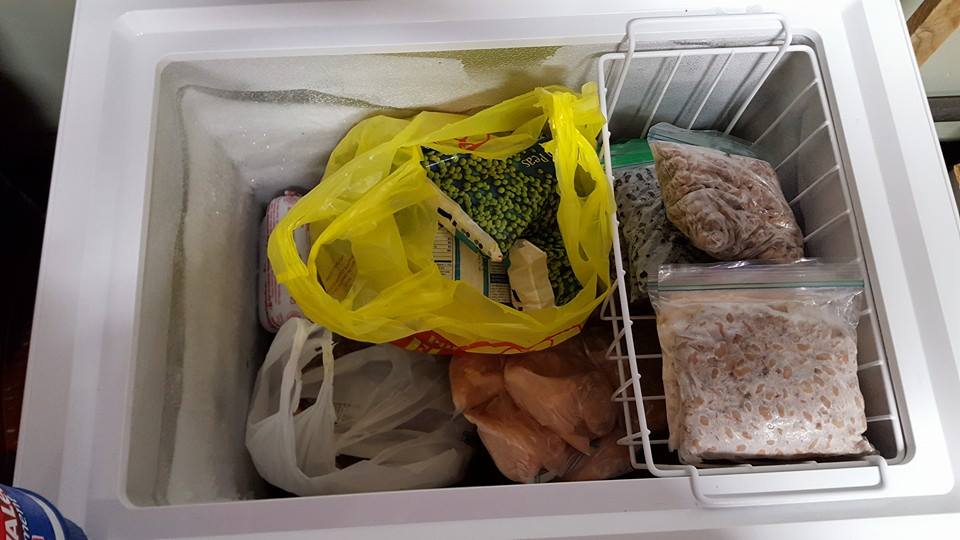
Shop your pantry, fridge and freezer first!
Before you head to the store or even make a meal plan, take an inventory of what you already have on hand. I think you’d be surprised to find out all the items that you have on hand that could make a meal.
This also reduces your waste. You’ll be sure to use up the random items that have been hiding in your cupboard and freezer and save yourself money by not throwing it away once it is expired.
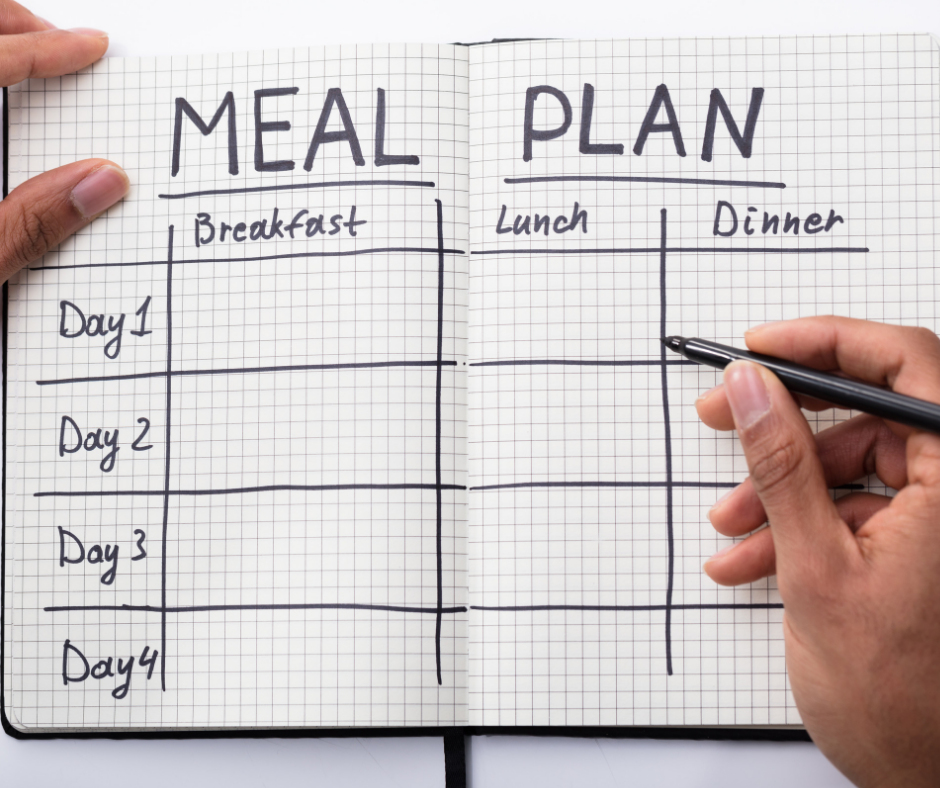
Meal Plan, Meal Plan, Meal Plan, Meal Plan
If you’ve ever read my blog before you know that I LOVE to meal plan. You can read about how and why I meal plan, but my favorite reason as to why I meal plan is to save money. I have tried to just “wing it” and I end up needing to run to the store more often which costs me time and money or we end up eating out more which is bad for my wallet and waistline.
Meal planning doesn’t have to be difficult. In fact, I post a weekly meal plan that includes all meals, snacks and drinks with a grocery list to go along with it. Literally, all of the guesswork has been done for you. My meal plans are always FREE, printable and available anytime. You can find my full archive (over 2 years worth) of meal plans here.

Choose in-season produce
My family eats A LOT of produce, in fact, it makes up one of the biggest parts of my grocery budget. The best way that I can stretch my produce dollars the furthest is to eat in-season produce as much as possible. There are some items that I buy all year long because their prices really don’t change a lot from season to season, but some items will change up to $2/pound depending on the time of year.
For instance, I rarely buy strawberries in the winter. First of all, I refuse to pay $3.99 for a pound of strawberries that will be eaten in one sitting, plus they don’t even taste all that great. I wait until they are at their peak (June in Michigan) and buy flats for $1/pound and freeze what we can’t get to before they spoil.
Farmer’s markets are a great way to get a feel for what is truly in season. A lot of times you can get some great deals too. If you are still unsure on when certain fruits and vegetables are in season, this is a great resource to check out.

Shop at Aldi (or another discount store)
Shopping at Aldi has saved me thousands and thousands of dollars over the years. Their prices beat any of the local stores in my area on almost every single item.
I do about 85% of my shopping there and am so impressed with their quality. I also love Aldi because it is a smaller store so I can get in and out much quicker. There is no need for sales fliers (although they do have them) or coupons. Here is a list I put together of all the THM on plan items I purchase at Aldi.
If you don’t have an Aldi in your area check around for other discount stores. Even if you only did half of your shopping at a discount store you will see the savings really add up.
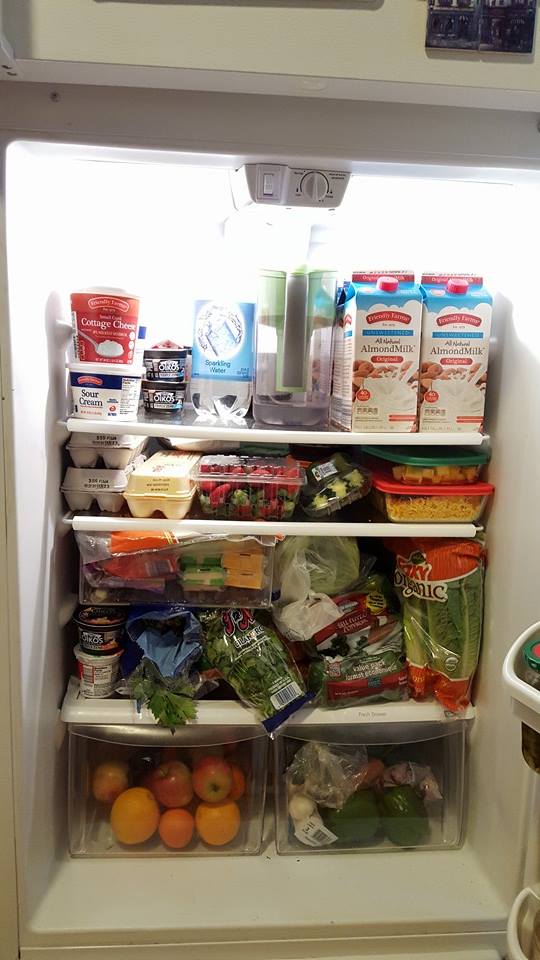
Shop mostly once a month
This is something that can take a little while to figure out. When I decided I wanted to shop mostly once a month I started by shopping every other week instead of every week. I figured out how much produce, dairy and non-perishables we needed to make it for those two weeks.
Once I got into a good rhythm with that, I was able to do a big shop once a month and then do a fill-in shop midway through the month for produce and milk. I’ve been doing this now for a couple of years so it’s like old hat to me, but it did take me a few months to get it down pat.
My grocery bill went down by about 20% just by making this one switch. The fewer times you step foot in that grocery store, the less money you’re going to spend. It’s as easy as that. Yes, it will take a bit more planning on your part, but it is totally worth it.
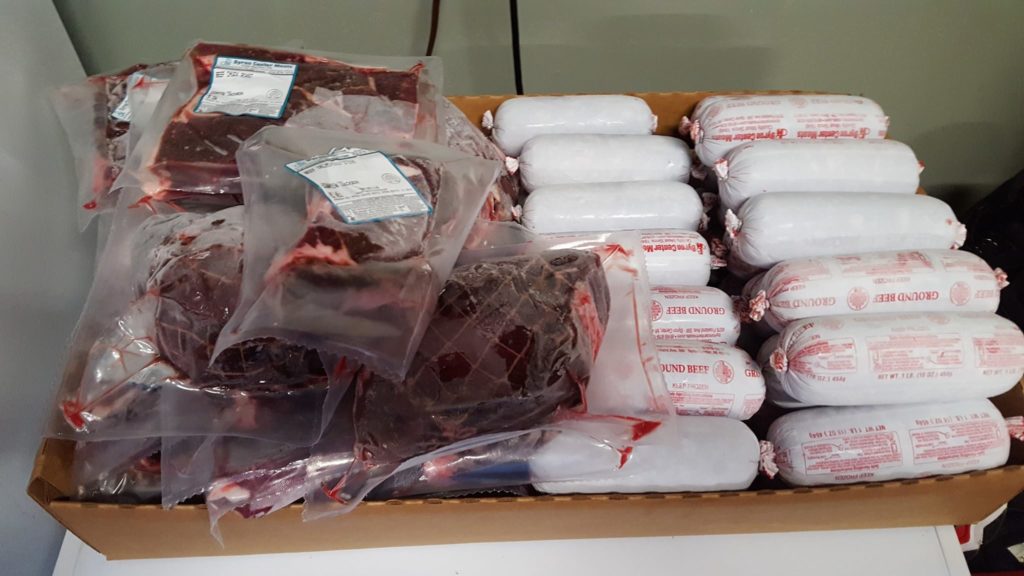
Buy meat (and other items) in bulk
This tip really saves us a lot of money every year. By buying our meat in bulk we can get better quality meat for a great price.
My family prefers grass-fed beef, but WOW is it expensive in the store. We have been buying a quarter of a cow from a local farmer for a few years. Not only is the quality amazing, but the prices are great too.
Now, it is a HUGE chunk of money all at once, but it is so great to be able to go out to my freezer at any time and grab some ground beef, a roast or even a steak. We have saved up for this purchase a couple of different ways. The first way is by setting aside $50/month out of our grocery budget. That adds up to $600 a year and that has been enough for our meat purchase.
The first time we bought a cow we had not been saving up the money, but we were able to use a chunk of our tax return to fund that meat purchase and then started saving monthly from that point on. So get creative, there are a lot of ways to save up for a bulk purchase. Sell some things around the house you don’t need, or use a bonus that you receive from work.
I also love to purchase things like flours, rice, beans, spices and oil in bulk. Sam’s Club, Costco and Gordon Food Service are all great stores to check for bulk items, but double check that you are truly getting a great price.
Sometimes the club stores don’t truly have the best bulk price. Local Amish stores, as well as your local grain elevator, are great places to check on bean and other grain bulk prices.
To figure out the price per unit (ounces, pounds, etc…), divide the package price by the unit and then compare to see if it’s a good deal. If it’s going to save me money, I go for it! To help offset the larger upfront cost of purchasing in bulk, I set aside a few dollars a week from my grocery budget in a separate envelope so I’m ready to make those purchases when I need to.
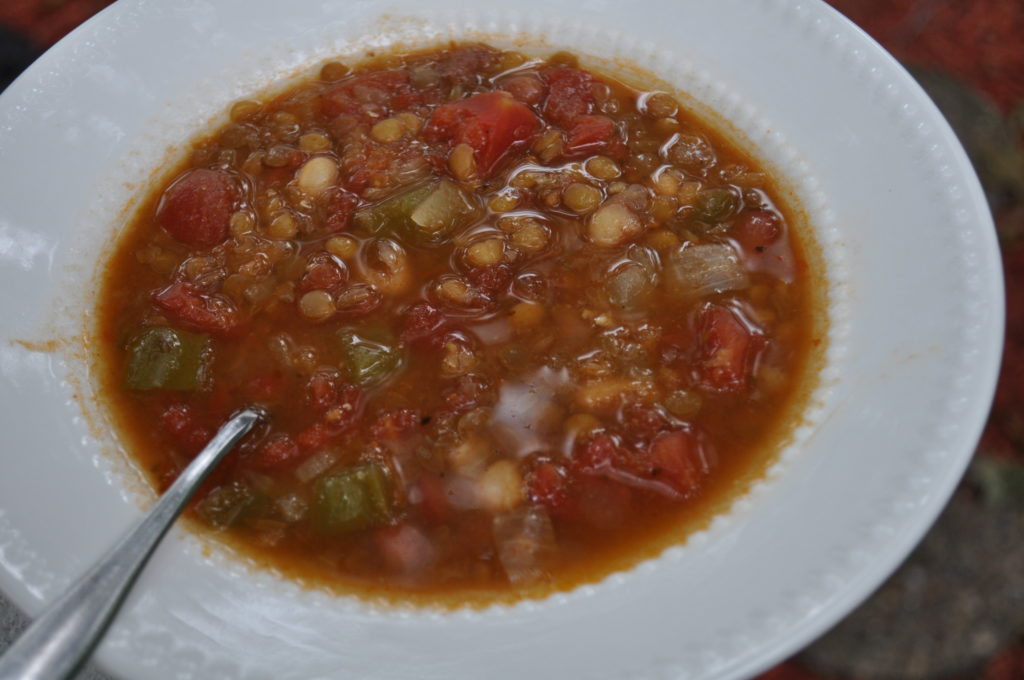
Eat meatless meals 1-2 times a week
One of the easiest ways to save big on your grocery budget is to eat a meatless dinner meal once or twice a week. It’s true, meat is usually one of my biggest grocery expenses. As I’m sure we’ve all noticed the prices keeps inching higher and higher. To compensate for this, my family and I eat one or two meatless dinner meals a week.
I’ve replaced the meat with proteins such as beans, legumes, and eggs. In doing so I save myself $5-10 a week depending on the cut of meat I’m replacing. Over the course of a year that’s $260-520! I put together a list of 20 THM Meatless Meals and the Trim Healthy Table book is also full of great meatless recipes.
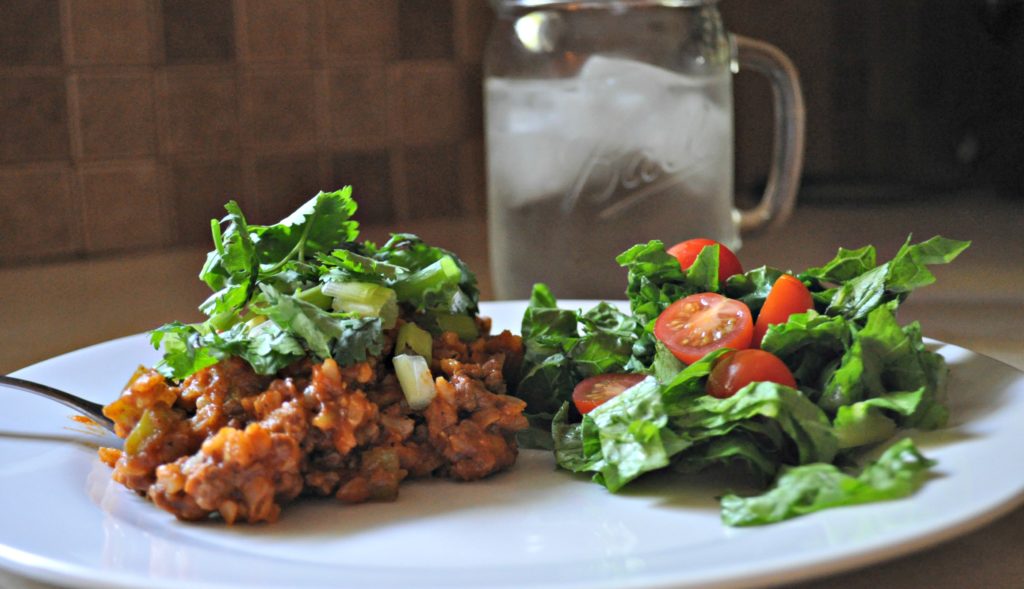
Meat is rarely the “star” of dinner
It is extremely rare that we have just a “hunk” of meat with sides for dinner. If you want to blow through your grocery money in a hurry then serve everyone their own chicken breast or steak for dinner.
But if you want to stretch your dollars then make meat part of the dinner rather than the main part. For instance, in the meal pictured above (Lovin’ TexMex Skillet) I use just one pound of ground beef and that will be more than plenty enough meat for the seven of us.
Meals like soups, stir-frys and casseroles are the perfect way to still have meat as a part of your dinner, but not the centerpiece. My husband is your typical meat and potato guy, but even he doesn’t miss having a huge hunk of meat at dinner anymore.

Make what you can from scratch
Making items from scratch can really save you some money. However, don’t kill yourself trying to make everything from scratch. Some things just aren’t worth the time versus money saved.
I make things like vegetable (and chicken) broth, taco seasoning, enchilada sauce and marinades. All of these recipes require less than 10 minutes of hands-on time. To me, that is worth my time to save the money. Also, all of these items taste better than their store-bought counterpart and are healthier too.

Use coupons for non-food items
Now hear me out on this one. Yes, it is true that coupons are mostly for foods that are NOT on plan. However, there are plenty of coupons for things like toiletries, diapers, paper products, cleaning products, and for on-plan items such as almond milk, butter, cheese, frozen fruits and vegetables and even some for fresh produce.
Many stores now have digital coupons that you can use right on your phone. It makes it SO easy to find the coupons you’re looking for and really takes hardly any time at all to clip them.
By utilizing coupons for these on-plan and non-food items that I’m already planning on purchasing, I typically save between $5-7 a week. By taking 10 minutes a week to clip coupons I can have up to $28 back a month in my grocery budget to utilize for healthy food items. Every little bit helps!
As a bonus tip, I use an app called Fetch Rewards. Each time I go grocery shopping, I come home and scan my receipt in the Fetch app. They reward you with points just for scanning your receipt that is redeemable for gift cards to places like Amazon, Target, Walmart, many restaurants and other stores too. You can scan a receipt from any major grocery store chain (i.e. Aldi, Walmart, Meijer, Kroger, HEB, etc…). You can download the app on your Android or iPhone. Use code H8DGC when you sign up and we’ll both receive 2,000 points. Gift card redemption starts at just 3,000 points.
No matter the size of your family, your location or food preferences there is always something new you can try to save on your grocery budget. Think of all the things you could do with the money you save just by slashing 20% off your grocery budget. I bet with these tips you could save even more!


I used your code and didn’t get any referral points:(
You should receive points once you upload your first receipt.
OH ok!
We like all kinds of beans and are eating low sodium. I cook my beans from dry until they are al-dente, drain them, put them on a cookie sheet and freeze. Once frozen place 1 1/2 cups in a sandwich bag, then put all the baggies in a larger freezer bag (another way to save since sandwich bags are cheaper but not sturdy enough for the freezer.) The beans are now ready to put into a recipe or a handful into a salad. One pound of beans yields 3 to 4 cans worth for close to the price of one can.
Are you including the bulk meat in your $450 budget?
Some years I do and some years I’ve used part of our tax return to pay for it. Right now it is about 50/50. The next beef order I do will mlre than likely be from our tax return because holidays and birthdays have made our food budget a little tighter.
My kids HATE mixed foods and never eat them (casseroles, stir-fry meals, etc….)… even spaghetti has to be separated: meatballs here, noodles (naked noodles for my oldest) there, and MAYBE a drizzle of sauce. The only “mixed” thing they eat is on rare occasion pierogies and tiny sausages cooked in the same pan- because they can easily separate them as there is no sauce or anything binding them together….. Unfortunately, this means meat is often is “own” thing…..
Also, I LOVE Aldi, but because my youngest has to have Oat Milk only, and my oldest two are lactose-free for yogurt, it often means going to 2-3 stores if I do Aldi….. and after 1-2 stores, they are DONE. I’m hoping to find more efficient ways to work around this, but with yet another baby on the way (#4!) I don’t for see much improvement…. Thank you for the tips and meal plan though!
I hear you! I get tired after too many stops. Some weeks, we start at Aldi then finish at Walmart. Some weeks, I’m too tired and we just go to Walmart. We also have Instacart which delivers for Aldi; they frequently have coupons to save on fees, plus not having to go into the store, I save on impulse buys from my son and husband ?
I also have 5 kiddo’s! We homeschool and are home for each and every meal. We spend about 1,000 a month on groceries! I just can’t believe you are eating THM and have fresh produce all month long. My kids can eat a whole container of strawberries at one meal and they all eat 1 apple each day. We are just always running out of food and I go to the grocery store at least twice a week for produce. We also buy grassfed beef from a local farmer. Do you have any blog posts where you show exactly what you get from the store and a day in the life of how you feed the kids? I just don’t see how I can do this BUT I really have got to get this food budget down like you’ve done!
We go through so much produce too. I have two teens that are both girls and I can see as my boys continue to creep closer to the teen years our budget will likely increase. That being said. I am the only one 90-100% THM the rest of my family is 50-75%. Don’t be discouraged that your grocery budget isn’t right where mine is. Remember that it depends where you live in the country, what stores and sales you have available, etc… There is always some way that everyone can trim their grocery budget, even if it’s only by $50/month, that still adds up to $600/year. I haven’t done a day in the life but I do share some more day to day food things on my Instagram page.